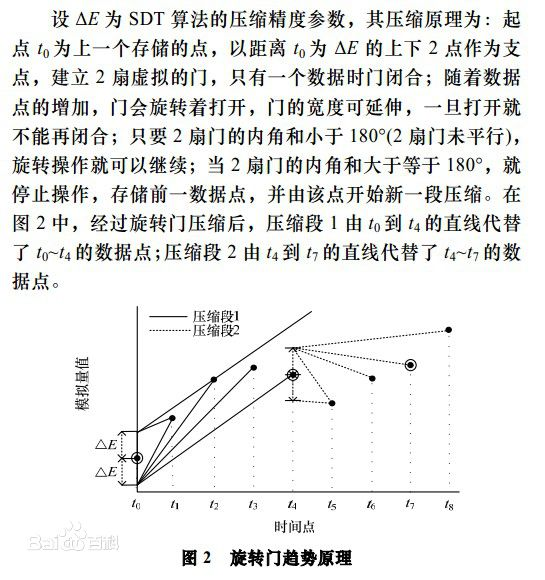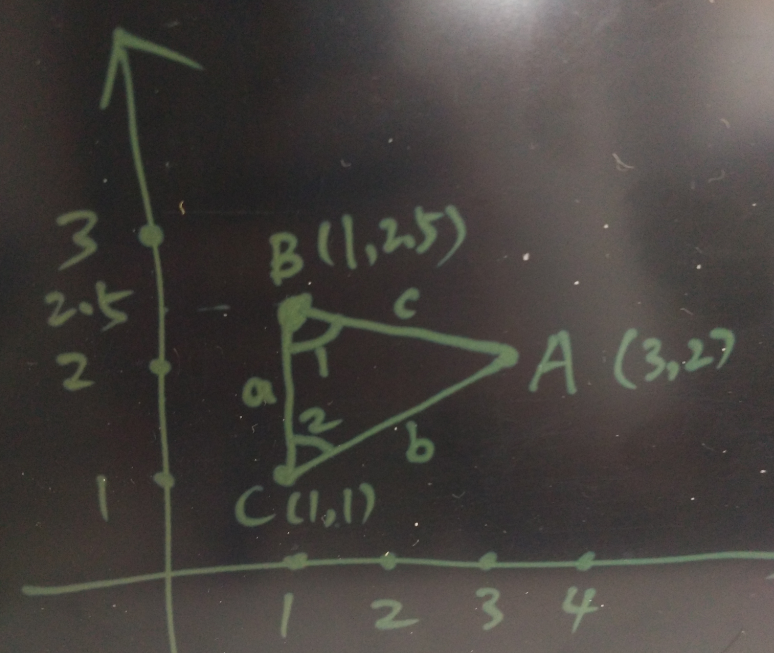PostgreSQL 三角函数的用法举例 - 已知3点求夹角(旋转门续)
本文共 5177 字,大约阅读时间需要 17 分钟。
背景
前几天写了一篇关于旋转门的数据压缩算法在PostgreSQL中的实现,里面用到了PostGIS里面的ST_Azimuth函数用来计算夹角,其实在PostgreSQL 中,我们还可以使用三角函数,以及三边来求夹角。

文中用到的计算夹角的方法如下
SELECT 180-ST_Azimuth( ST_MakePoint(o_x, o_val+i_radius), -- 门上点 ST_MakePoint(v_x, v_val) -- next point )/(2*pi())*360 as degAz, -- 上夹角 ST_Azimuth( ST_MakePoint(o_x, o_val-i_radius), -- 门下点 ST_MakePoint(v_x, v_val) -- next point )/(2*pi())*360 As degAzrev -- 下夹角 INTO v_angle1, v_angle2;
余弦定理
cosA=(b²+c²-a²)/(2bc)

定点为A、B、C; 对的边分别为a、b、c;
PostgreSQL 支持的三角函数
| Function (radians) | Function (degrees) | Description |
|---|---|---|
| acos(x) | acosd(x) | inverse cosine |
| asin(x) | asind(x) | inverse sine |
| atan(x) | atand(x) | inverse tangent |
| atan2(y, x) | atan2d(y, x) | inverse tangent of y/x |
| cos(x) | cosd(x) | cosine |
| cot(x) | cotd(x) | cotangent |
| sin(x) | sind(x) | sine |
| tan(x) | tand(x) | tangent |
例子
已知三个点A(3,2),B(1,2.5),C(1,1)。 求夹角B, C。

套用余弦公式
cosB=(a²+c²-b²)/(2ac) cosC=(b²+a²-c²)/(2ba)
首先求三条边长
postgres=# select point_distance(point(3,2), point(1,2.5)) as c , point_distance(point(3,2), point(1,1)) as b , point_distance(point(1,1), point(1,2.5)) as a; c | b | a ------------------+------------------+----- 2.06155281280883 | 2.23606797749979 | 1.5(1 row)
运算如下
cosB=(a²+c²-b²)/(2ac) =(1.5^2 + 2.06155281280883^2 - 2.23606797749979^2) / (2*1.5*2.06155281280883) =0.24253562503633260164 cosC=(b²+a²-c²)/(2ba) =(1.5^2 + 2.23606797749979^2 - 2.06155281280883^2) / (2*2.23606797749979*1.5) =0.44721359549995825124
求夹角 1 度数
postgres=# select acosd(0.24253562503633260164); acosd ------------------ 75.9637565320735(1 row)
求夹角 2 度数
postgres=# select acosd(0.44721359549995825124); acosd ----------------- 63.434948822922(1 row)
比对使用PostGIS计算的结果一致
test=> SELECT 180-ST_Azimuth( ST_MakePoint(1,2.5), -- 门上点 ST_MakePoint(3,2) -- next point )/(2*pi())*360 as degAz, -- 上夹角 ST_Azimuth( ST_MakePoint(1,1), -- 门下点 ST_MakePoint(3,2) -- next point )/(2*pi())*360 As degAzrev ; degaz | degazrev ------------------+----------------- 75.9637565320735 | 63.434948822922(1 row)
源码
三角函数属于浮点运算中的函数
src/backend/utils/adt/float.c
/* * acosd_q1 - returns the inverse cosine of x in degrees, for x in * the range [0, 1]. The result is an angle in the * first quadrant --- [0, 90] degrees. * * For the 3 special case inputs (0, 0.5 and 1), this * function will return exact values (0, 60 and 90 * degrees respectively). */static doubleacosd_q1(double x){ /* * Stitch together inverse sine and cosine functions for the ranges [0, * 0.5] and (0.5, 1]. Each expression below is guaranteed to return * exactly 60 for x=0.5, so the result is a continuous monotonic function * over the full range. */ if (x <= 0.5) { volatile float8 asin_x = asin(x); return 90.0 - (asin_x / asin_0_5) * 30.0; } else { volatile float8 acos_x = acos(x); return (acos_x / acos_0_5) * 60.0; }}/* * dacosd - returns the arccos of arg1 (degrees) */Datumdacosd(PG_FUNCTION_ARGS){ float8 arg1 = PG_GETARG_FLOAT8(0); float8 result; /* Per the POSIX spec, return NaN if the input is NaN */ if (isnan(arg1)) PG_RETURN_FLOAT8(get_float8_nan()); INIT_DEGREE_CONSTANTS(); /* * The principal branch of the inverse cosine function maps values in the * range [-1, 1] to values in the range [0, 180], so we should reject any * inputs outside that range and the result will always be finite. */ if (arg1 < -1.0 || arg1 > 1.0) ereport(ERROR, (errcode(ERRCODE_NUMERIC_VALUE_OUT_OF_RANGE), errmsg("input is out of range"))); if (arg1 >= 0.0) result = acosd_q1(arg1); else result = 90.0 + asind_q1(-arg1); CHECKFLOATVAL(result, false, true); PG_RETURN_FLOAT8(result);} man asin NAME asin, asinf, asinl - arc sine functionSYNOPSIS #includedouble asin(double x); float asinf(float x); long double asinl(long double x);///CONFORMING TO C99, POSIX.1-2001. The variant returning double also conforms to SVr4, 4.3BSD, C89.SEE ALSO acos(3), atan(3), atan2(3), casin(3), cos(3), sin(3), tan(3)
祝大家玩得开心,欢迎随时来 阿里云促膝长谈业务需求 ,恭候光临。
阿里云的小伙伴们加油,努力 做好内核与服务,打造最贴地气的云数据库 。
转载地址:http://qwdel.baihongyu.com/
你可能感兴趣的文章
二分查找及其变种简单易懂的模版
查看>>
mysql优化小技巧
查看>>
CardinalSpline样条曲线(沿着正方形路线走)
查看>>
设计模式之观察者设计模式
查看>>
HDOJ_ACM_Bone Collector
查看>>
第三章:垃圾回收器:垃圾回收器的两种算法
查看>>
力扣算法题—091解码
查看>>
两直线异面的充要条件
查看>>
2018软工实践_团队作业_1
查看>>
leetcode-001-Two sum
查看>>
eclipse Java注释模版
查看>>
LCS(打印全路径) POJ 2264 Advanced Fruits
查看>>
逆序数 UVALive 6508 Permutation Graphs
查看>>
读《大学之路》有感③
查看>>
TYVJ P1068 STR Label:KMP匹配 不懂
查看>>
AIX系统日志
查看>>
dataguard类型转换与模式转化
查看>>
Linux下解决中文乱码问题
查看>>
C++ STL之LIST详解A
查看>>
ANG-----全方位保障您的数字资产安全
查看>>